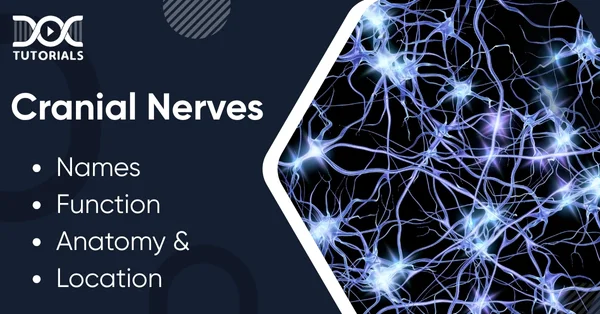Cranial Nerves: Names, Function, Anatomy, and Location

The human nervous system conducts the symphony of body functions with seamless synchronisation, coordinating everything from voluntary movements to involuntary physiological functions.
The 12 cranial nerves, which form the foundation of this network, are usually referred to as the “gateway” between the body and the brain. Understanding cranial nerve anatomy and their diverse functions in detail is essential for medical students preparing for the NEET PG exam.
DocTutorials offers a comprehensive learning plan that helps aspiring medical students grasp these concepts efficiently.
Keep reading to learn more about cranial nerves!
What are Cranial Nerves?
The cranial nerves are 12 pairs of nerves that come from the brain and brainstem, not the spinal cord. Here is a detailed overview:
- These nerves send electrical messages from the brain to other parts of the head, face, neck, and even organs inside the body.
- Cranial nerves are important because they help you see, smell, taste, hear, and control the muscles in your face.
- The brainstem is where most cranial nerves originate, and they exit the skull through foramina to reach their target areas.
- The olfactory (I) and optic (II) nerves are part of the central nervous system, but most of the other nerves are part of the peripheral nervous system.
- Depending on their function, cranial nerves can be motor, sensory, or both.
What are the Names of the 12 Cranial Nerves, and What Do They Do?
The 12 cranial nerves each have a unique and important job. They control varied sensory and motor tasks in the head, neck, and even the upper torso. Here is a detailed look at what the cranial nerves do:
- Olfactory Nerve (CN I)
This nerve transmits sensory signals from the nasal cavity to the brain, conveying the sense of smell. Damage to this nerve can make you lose your sense of smell and taste (anosmia).
- The Optic Nerve (CN II)
The optic nerve plays a crucial role in vision. It sends visual information from the retina in the eye to the brain. Depending on the severity of the injury, this nerve can cause vision problems, issues with the visual field, or even complete blindness.
- Oculomotor Nerve (CN III)
Most eye movements, eyelid lifting, and pupil constriction are controlled by the oculomotor nerve. It helps the eye concentrate and adjust to changes in light. When you are hurt, your eyelids may droop (ptosis), your pupils may dilate, and your vision may become blurry.
- Trochlear Nerve (CN IV)
The trochlear nerve helps the eyes move down and inward, particularly the superior oblique muscle. Damage to this nerve can make it hard to glance down, especially when reading or going downstairs.
- The Trigeminal Nerve (CN V)
This nerve sends signals from the face and controls the muscles needed for chewing. It is made up of three parts:
Ophthalmic (eyes and forehead), Maxillary (upper lip and cheeks), and Mandibular (lower lip and jaw)
Damage may cause your face to feel numb, tingle, or experience intense pain, similar to the symptoms of trigeminal neuralgia.
- Abducens Nerve (CN VI)
The lateral rectus muscle moves the eye side to side, while the abducens nerve controls this movement. When the eye turns inward (esotropia), it might cause double vision when looking to the side.
- The Facial Nerve (CN VII)
This nerve governs how your face moves, how much tears and saliva you make, and how the front two-thirds of your tongue tastes. Bell’s palsy can cause damage that leads to paralysis on one side of the face, loss of taste, and dryness of the mouth or eyes.
- Vestibulocochlear Nerve (CN VIII)
The auditory vestibular nerve, also known as the auditory vestibular nerve, has two branches: the cochlear nerve, which is responsible for hearing, and the vestibular nerve, which is responsible for balance. It helps people stay balanced and lets them hear.
Injuries might cause vertigo, dizziness, a shaky walk, or hearing loss.
- The Glossopharyngeal Nerve (CN IX)
This nerve is responsible for taste sensation from the back third of the tongue, as well as for swallowing and salivation. It also helps manage blood pressure through baroreceptors.
Damage could make it harder to swallow, taste, and have heart responses.
- Nerve Vagus (CN X)
The vagus nerve is the most important parasympathetic nerve. It controls things that happen without you thinking about them, like digestion, heart rate, blood pressure, breathing, and even your emotions. It also helps with speaking and swallowing.
Damage to this nerve may cause hoarseness, trouble swallowing, digestive difficulties, or irregular heartbeats.
- Cranial Nerve (Accessory) (CN XI)
It comes from the spinal segments (C1–C5) and the medulla. It enters the skull by the foramen magnum and leaves through the jugular foramen. It supplies blood to the sternocleidomastoid and trapezius muscles, which enable you to turn your head and raise your shoulders.
- Cranial Nerve (Hypoglossal) (CN XII)
It starts in the medulla and leaves through the hypoglossal canal. It solely connects to the intrinsic and extrinsic tongue muscles, which are needed for making sounds and moving food around.
What is the Anatomy of Cranial Nerves?
Cranial nerves are highly specialised structures that originate directly from the brain and differ in shape and function. They enable communication between the central nervous system (CNS) and peripheral structures. Here are the details about their anatomy:
- There are twelve pairs of cranial nerves, which are numbered I to XII based on the order in which they leave the brain.
- Foramina are small openings in the skull that each neuron passes through when it leaves the brain. Each nerve then follows a distinct path to its sensory or motor destination.
- Depending on the type of fibres they contain, cranial nerves can be sensory (such as the olfactory and optic nerves), motor (like the oculomotor and trochlear nerves), or mixed (like the trigeminal and facial nerves).
- The olfactory nerve (CN I) has sensory fibres that pick up smells and send them from the nasal mucosa to the brain.
- The optic nerve (CN II) transmits data between the retina and the visual cortex in the brain, which is how we perceive vision.
- The ocular muscles are controlled by nerves such as the oculomotor (CN III), trochlear (CN IV), and abducens (CN VI).
- The trigeminal nerve (CN V) has three big branches: the ophthalmic, maxillary, and mandibular. These branches control sensation in the face and chewing movements.
Where in the Brain are the Cranial Nerves?
Here is how different kinds of cranial nerves are arranged in the brain to serve their own specific functions:
- The olfactory (CN I) and optic (CN II) cranial nerves come straight from the cerebrum, from the anterior cranial fossa, which is different from the other cranial nerves.
- The other eleven cranial nerves (CN III–XII) come from different parts of the brainstem, which connects the brain to the spinal cord.
- The midbrain and pons give rise to cranial nerves III (oculomotor), IV (trochlear), and VI (abducens), which govern the movement of the eyes and pupils.
- The trigeminal nerve (CN V) runs along the middle cranial fossa, crossing both sensory and motor areas on the face.
- The facial (VII), vestibulocochlear (VIII), glossopharyngeal (IX), vagus (X), accessory (XI), and hypoglossal (XII) nerves leave the back of the skull and spread out to control functions in the face, neck, chest, and even the stomach.
- The vagus nerve (CN X) is the longest cranial nerve. It goes from the medulla to the abdomen. It affects how fast the heart beats, how food is broken down, and how you breathe.
FAQs About Cranial Nerves
- What is the shortest cranial nerve?
When it comes to axonal length, the trochlear nerve is the shortest of all the cranial nerves. It may be small, but it helps control the movement of the eyes, especially when they look down.
- What can I do to maintain my cranial nerves healthy?
Some things that can harm the cranial nerves cannot be stopped. Still, you can help keep your nerves healthy by making good lifestyle choices, such as managing your weight, eating healthy foods, exercising regularly, managing chronic conditions like diabetes or high blood pressure, limiting alcohol consumption, and avoiding smoking.
- What is the job of the optic nerve?
The optic nerve lets you see. It sends visual information from the retina of the eye to the brain, where it is processed, allowing individuals to see and understand it as visual information.
- What happens if the vestibulocochlear nerve gets hurt?
Damage to the vestibulocochlear nerve can cause symptoms such as dizziness, vertigo, or a sensation of spinning, in addition to problems with hearing or balance.
- Which cranial nerve is the longest?
The vagus nerve (cranial nerve X) is the longest cranial nerve. It originates from the medulla of the brainstem and travels to the abdomen, where it connects to several vital organs.
Conclusion
Gaining a thorough understanding of the 12 cranial nerves is a critical milestone if you are preparing to sit for the NEET PG exam. A clear understanding of cranial nerve locations, their anatomy, and the functions of each nerve assists in comprehending a broad spectrum of clinical presentations.
With organised learning materials and professional instruction, DocTutorials offers comprehensive NEET PG study materials focused on cranial nerves. Through our structured methodology and professional guidance, aspiring medical students can achieve their goal of becoming successful doctors with a profound grasp of the medical field.
Check out our courses today!
Latest Blogs
-

NEET SS Exam 2024: Analysis, Key Dates, Counselling
The NEET SS 2024 exam kicked off on March 29, 2025. Over two days and two slots, candidates across 13…
-

NEET PG Registration 2025: An Essential Guide For Exam Prep
The NEET PG registration, which is conducted online, is a crucial step in the exam process. Filling out the NEET…
-

NEET PG Syllabus 2026: A Must-Have Complete Guide for Exam Success
The NEET PG Syllabus acts as one of the foundation stones for aspiring postgraduate medical students like you who are…




